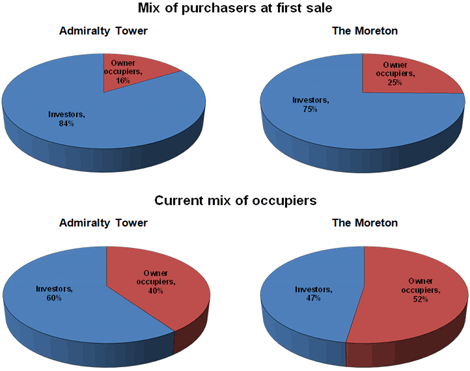How important are owner occupiers in the inner Brisbane apartment market?
Owner occupiers represent a small but important component of the inner Brisbane apartment market. At the youngest end, they represent occupiers who could potentially be occupying greenfield development in the outer suburbs and thus helping to reduce the requirement for new infrastructure. Similarly, at those at the older end are likely to have freed up an existing established home for the next generation to move into.
As part of the preliminary work for our upcoming Inner Brisbane Apartments 2013 to 2020 report, we have taken a closer look at the actions of owner occupier purchasers by undertaking an analysis of two buildings that were built targeting different markets. Both buildings were marketed and completed in the early to mid 1990s, which allows us to identify long term trends.
Admiralty Towers in Howard Street faces the Brisbane River and contains 152 apartments that were pitched at the investor end of the market.
The Moreton in the Dockside development is located in Kangaroo Point and also faces the Brisbane River, with 106 apartments and was pitched at higher price points, and presumably being more attractive to owner occupiers.
Reflecting the market positioning of each building, a higher average pre-sale price was achieved at The Moreton, at $425,000 per apartment versus $377,000 per apartment at Admiralty Towers—although this could also reflect the mix of apartments and location as well as the size/quality of apartments.
An analysis of sales shows that despite the different price points, pre-sales were dominated by investors (which include second home purchasers) in both projects, who accounted for 75% of off the plan sales in The Moreton and as much as 84% of apartments in Admiralty Towers (see chart below).
Click to enlarge
Source: PriceFinder
Subsequent sales show that both buildings attracted a higher level of owner occupier purchasers after completion, although they favoured the higher priced The Moreton project at Kangaroo Point. The majority (52%) of apartments in The Moreton are now owner occupiers, and while investors are still the majority in Admiralty Towers, owner occupiers now fill out 40% of apartments.
This reflects two things:
Investors are attracted at pre-sale, most likely due to the negative gearing benefits of depreciation, etc, being at their greatest. There may also be stamp duty benefits in purchasing off-the-plan.
Owner occupiers prefer to come in after the building is completed. As the negative gearing benefits are not relevant to an owner occupier, there is less incentive to purchase off-the-plan, while they can also “touch and feel” the dwelling that they will be living in. Moreover, the timing of their requirement for an apartment may not necessarily coincide with the timing of the construction of a new apartment project. For example, a first home buyer could wait up to three years or more between signing the contract and when their apartment is completed, while upgraders and downsizers face a more uncertain market in the future to sell their existing dwelling before moving in.
Interestingly, there was a greater turnover of apartments in The Moreton—88% of apartments have recorded a re-sale compared to 74% in Admiralty Towers—despite the perception of owner occupiers having more stable occupancy. Perhaps for many owner occupiers of apartments, this represents a stepping stone into another dwelling.
Nevertheless, despite the higher turnover, apartments in The Moreton achieved higher price growth on average than Admiralty Towers, with sales on average achieving a rate of growth of 3.9% per annum, compared to 3.6% per annum. The margin may not be substantial, but it builds up in aggregate over an extended holding period.
What does this mean?
While a development can be developed and marketed as attractive to owner occupiers, developers are nevertheless reliant on investor purchasers to achieve the pre-sales for development finance to proceed. This poses a problem for policy makers, who would like a greater level of owner occupiers living in apartments.
The limited owner occupier demand at pre-sale means that developers are likely to build stock at a price point to be more attractive to investor purchasers in order to achieve the required pre-sales in a timely manner. Owner occupiers instead then prefer to purchase the finished product, where the look and quality of the apartment is a known quantity. However, a development developed and priced to maximise investor sales may not necessarily be attractive to owner occupiers in the future.
Even in conducive locations where a developer may develop and seek to target a higher share of owner occupiers for off-the-plan sales, investors are a necessary—and indeed compulsory—part of the marketing equation. Only smaller or unique buildings can get away with being purchased in majority by future owner occupiers, as they could potentially face a more limited opportunity to buy in at re-sale. Nevertheless, the prospect of greater future price growth and potential onsale to either another investor or an owner occupier can play a part in marketing to investors. Such a project would also attract a larger, although probably still a minority, share of owner occupiers provided the project is developed as being attractive to this market upon completion.
Angie Zigomanis is senior manager of BIS Shrapnel.
